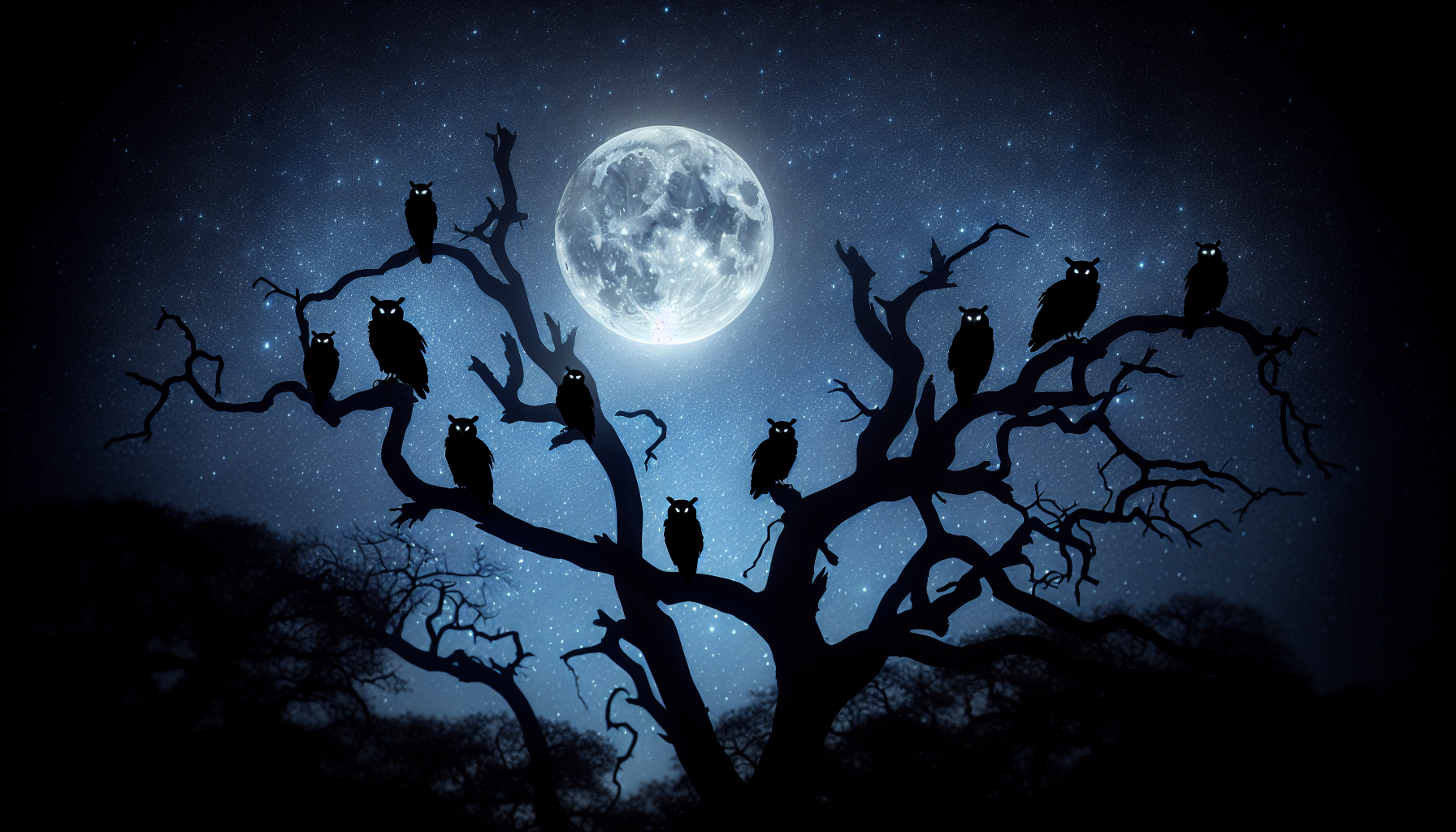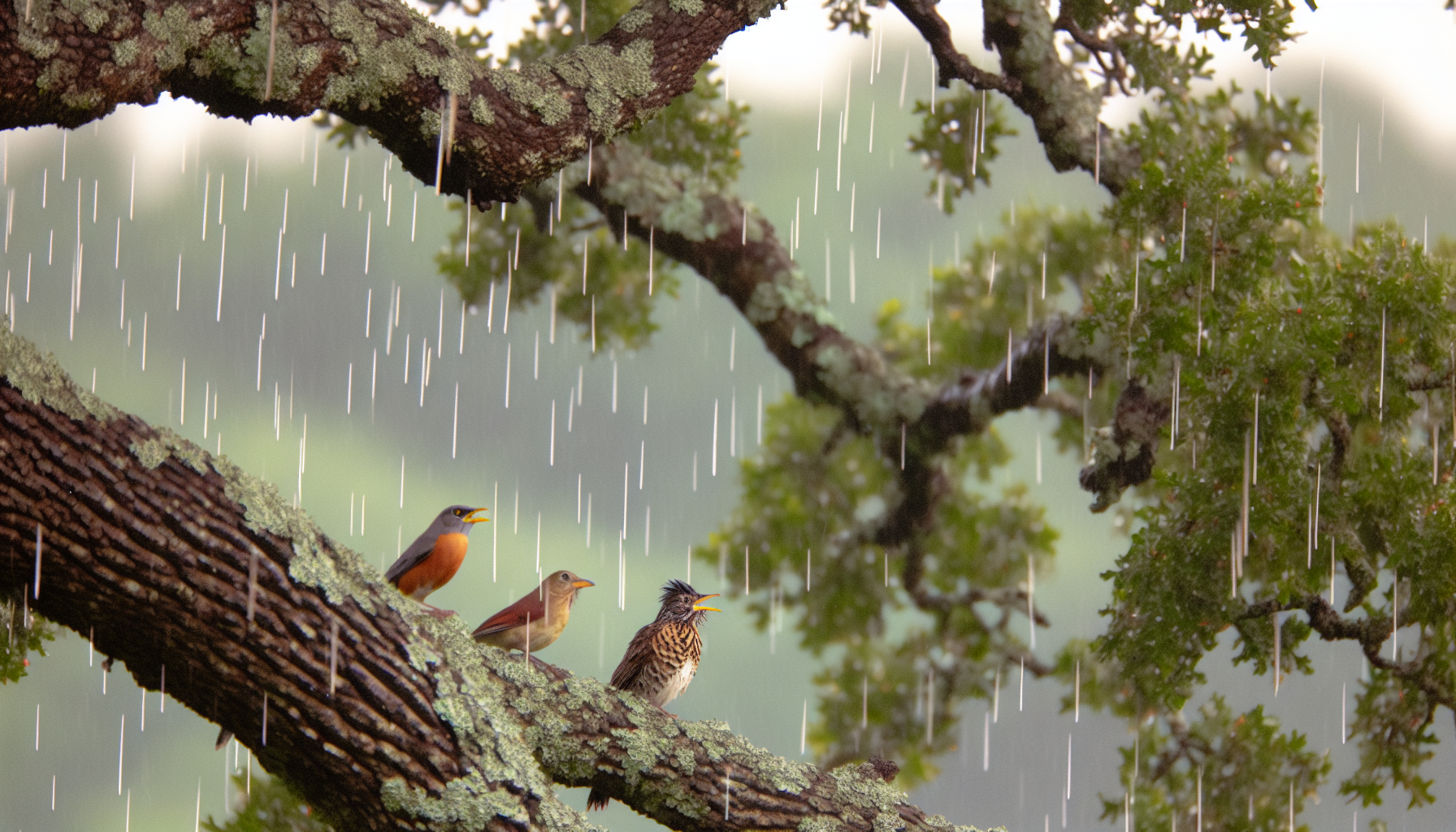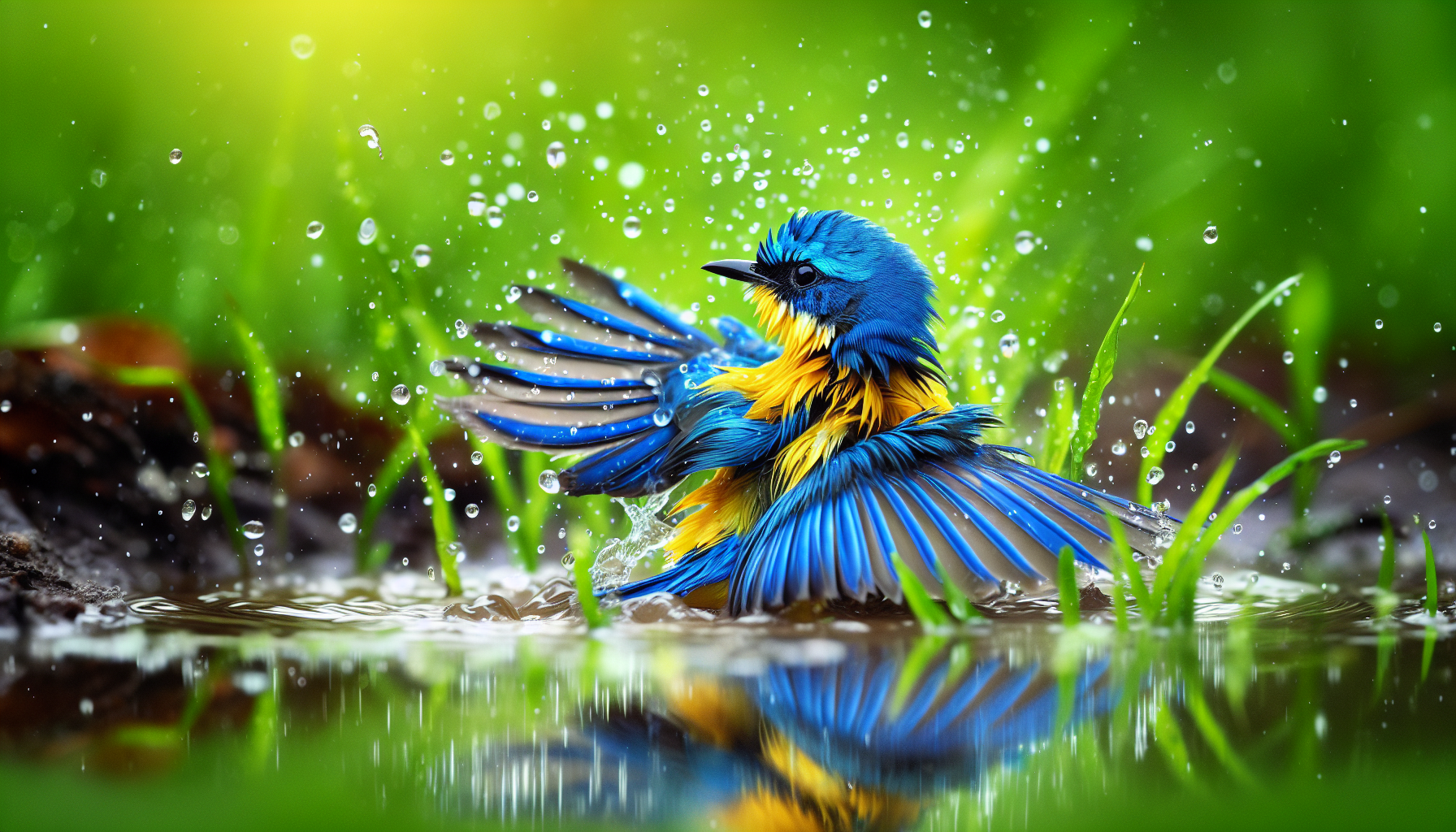Understanding Bird Behavior in Rain and at Night
How do birds behave when faced with rain or the dark of night? This article will uncover the strategic adjustments birds make to survive these conditions. They range from energy-saving techniques in the midst of a storm to specialized nocturnal adaptations for life after sunset. Read on to discover the intriguing world of bird behavior in rain and at night.
Key Takeaways
Birds adapt their behavior during rain to conserve energy and stay dry, using natural and man-made shelters, feather adaptations, and facing into the wind.
At night, birds have unique sleep patterns and some engage in nocturnal activities, while artificial light and noise from urban environments can disrupt their natural behaviors.
After the rain, birds resume activities like feeding and socializing, taking advantage of increased food availability and using the time to bathe and preen.
Navigating the Storm: How Birds Cope with Rain

When the sky darkens and the first drops of rain start to fall, birds instinctively change their behavior to cope with the impending rain storms. The intensity of the rain influences their response, which can vary from seeking shelter to halting their activities. Large birds like gulls, hawks, pigeons, or herons usually sit still during heavy rain, patiently waiting for the storm to pass.
However, it’s not just about seeking shelter; birds also have to conserve energy during a storm. Torrential rain makes it more strenuous for birds to maintain their body temperature. To tackle this, birds perch under tree cover or on a fence wire facing into the wind, which reduces air resistance and body heat loss. Particularly during heavy rains that prompt pronounced shelter-seeking behavior, conserving energy is pivotal for their survival.
Shelter Strategies
When it comes to heavy rain, small birds demonstrate remarkable resourcefulness as they seek shelter. They utilize natural environments like bushes, trees, and tree branches, as well as dense foliage. Smaller birds, and particularly vulnerable chicks, find refuge in these places to prevent hypothermia due to rapid heat loss.
In addition to natural structures, birds also take advantage of human-made structures such as barns, bridges, and building eaves during heavy rain. Interestingly, not all birds seek land during a storm. Larger seabirds may weather the storm at sea, whereas smaller land birds often cease singing and seek immediate shelter on land.
Feather Adaptations

Birds’ feathers are marvelously adapted to weather the rain. These natural umbrellas are designed to be water-resistant, allowing rain to roll off without being absorbed, thanks to the structural arrangement of feathers and the presence of preen oil. In fact, feathers shed rain quite effectively. Some feathers can even change structure to become more water-resistant in rainy conditions, and flattening of feathers during heavy rain increases their water resistance.
Feathers have several important functions for birds:
They provide insulation, protecting birds against cold temperatures during rain. This insulation is due to the barbs and barbules that trap air and heat, offering a layer of warmth.
During preening, birds apply oil from their oil glands, a necessary step in maintaining water resistance and keeping feathers pliable.
These waterproof feathers play a crucial role in keeping birds dry and maintaining their body heat.
Energy Conservation
Birds must conserve energy during rain to ensure their survival. They achieve this by reducing activity levels and adopting behaviors that minimize heat loss. For instance, when perched, birds may face into the wind to reduce air resistance and limit the loss of body heat.
During extended periods of rainfall, small birds tend to enter a state of torpor to conserve energy and overcome the energy deficit. Smaller birds, including chicks, are particularly vulnerable during prolonged rainfall as they lose heat more rapidly than larger birds, necessitating frequent feeding to maintain energy. These energy conservation strategies underline the resilience of birds in the face of adverse weather conditions.
Avian Nocturnal Habits: Understanding Birds at Night

As the sun sets and the world descends into darkness, avian lives take a fascinating turn. Most songbirds sleep on a secluded branch or tree cavity, fluffing out their down feathers and tucking their beak into back feathers. Some birds, however, have evolved extraordinary adaptations for living in the night, finding unique ways to birds hide from potential threats.
For instance, frigate birds can sleep while flying over the ocean, using half of their brain at a time during soaring or gliding flight. And then there are the night owls, literally, who are active when most of the world sleeps.
Sleep Patterns of Birds
Birds typically align their sleep patterns with natural light cycles, sleeping at dusk and waking up at dawn. They sleep in the same areas where they are active during the day, rather than migrating to distinct sleeping locations. To conserve body heat through the night, they fluff out down feathers, tuck in their beak and legs, and adopt sleeping postures that reduce heat loss.
During winter nights, birds may roost in different ways to stay warm:
Cardinals, Blue Jays, and finches may roost in dense evergreens or tunnel into snow to leverage their body heat for warmth.
Woodpeckers and chickadees prefer sleeping in tree cavities.
Some birds, like the Anna’s Hummingbirds, can enter a state of torpor to thermally regulate during cold, wet conditions.
Nocturnal Bird Activity
Nocturnal birds such as owls get active as the sun sets, embarking on hunting and other activities, while most birds remain quiet and at rest during the night. Some birds have even developed the ability to sleep while in flight.
Migratory birds like the Alpine Swift exhibit adaptations like unihemispheric slow-wave sleep (USWS) which allows them to sleep while flying, thus enabling non-stop travel during nocturnal migration.
The Impact of Urban Environments
Urban environments with their artificial lighting and noise can disrupt birds’ natural behaviors and sleep patterns. Artificial light at night (ALAN) can alter activity patterns and physiologically affect hormone levels and stress responses in birds. Night-flying birds can become disoriented or attracted by artificial lighting, often resulting in unintended aggregation or collision with illuminated buildings and structures.
Despite these challenges, birds are incredibly adaptive. They adjust their vocalizations to cope with noise pollution. They also utilize the microclimates provided by buildings, taking advantage of the warmth from vent systems to maintain their temperature during rain.
The Symphony of Rain: Birds Singing in Wet Weather

Have you ever noticed that birds seem to chirp merrily after a spell of rain? Aside from being delightful to our ears, this intriguing phenomenon plays a vital role in bird behavior. Birds chirp during rain to communicate with other birds about the presence of food and to establish territorial boundaries.
Rainfall can lead to worms and insects emerging, signaling an excellent opportunity for feeding, which birds announce by chirping. However, the sound of rain may mask their songs, unless it is a light rain.
Vocal Communication
Chirping after rain serves as a means for birds to communicate territory and reestablish social bonds that may have been disrupted during the rain. The transmission of birds’ songs is enhanced in the damp, post-rain environment, which is crucial for courtship and mating behaviors.
Rain can act to amplify a bird’s song, which is advantageous in communication during and immediately following rainy conditions as it makes the song sound closer. This amplification phenomenon highlights how the natural elements can directly influence avian communication.
The Search for Food
Rain can lead to an increased availability of food, such as worms and insects, prompting birds to become more vocal and active in their search for sustenance. Certain bird species, like robins, become significantly more vocal and active during and after heavy rains, as worms and insects are more available and accessible.
During heavy rain, birds that typically hunt in flight may opt to forage on the ground. This behavior, observed in species like robins, involves actively seeking out more accessible insects. However, insectivorous birds and raptors can face a potential crisis during heavy rain as their prey becomes less active, increasing their risk of hypothermia due to the lack of available food.
Species-Specific Songs
Reflecting their adaptations and ecological niches, different bird species exhibit unique chirping behaviors after rain. For instance, Robins and Nightingales use chirping after rain for establishing territorial boundaries and courtship, while Sparrows and Woodpeckers use short calls and rhythmic tapping for communication and foraging.
After a rain shower, birds produce a variety of sounds and songs. Some examples include:
Mockingbirds mimicking the sounds of other species
Blackbirds vocalizing loudly as part of their territorial displays
Warblers producing high-pitched, rapid songs related to mating behaviors
Hummingbirds chirping rapidly, often related to feeding behaviors
The diversity of these songs demonstrates the richness of avian communication in a few other species, especially after a rain shower.
Flight Challenges: How Birds Fly in Adverse Weather
Flying in the rain is no easy feat. Birds may experience difficulties flying in heavy rain due to the reduced air density, which compromises their aerodynamic lift. This presents a significant challenge for birds, making it harder for them to maintain altitude and navigate through the downpour.
Aerial Maneuverability
Birds are master pilots, capable of executing intricate maneuvers even in adverse weather conditions. The low atmospheric pressure and high humidity during rainstorms make air less dense, which reduces the aerodynamic lift needed for flight, presenting a challenge for birds. To mitigate this, low flying birds in rainy conditions often reduce their flight altitude. Furthermore, they use natural cover such as trees or cliffs to shield themselves from heavy rain and maintain clearer visibility during flight.
Hummingbirds have been observed shaking their heads to dispel water while maintaining flight, which aids in their maneuverability and feather maintenance in rain. Despite these adaptations, birds often avoid flying during rainstorms as it becomes energetically costly and difficult to navigate.
Grounded by the Rain
There are times when the downpour is too heavy and birds choose to stay grounded. During such times, they often go silent to conserve energy and minimize movement. Staying grounded is a protective measure that birds employ during heavy rain. It’s a smart strategy – why risk flying when the weather is against you?
Long-Term Weather Effects
Migratory birds may delay their flights when encountering extended periods of rain, conserving energy until weather conditions improve, showing how prolonged rain can have long-term effects on bird behavior. Moreover, during prolonged rain, birds face an energy deficit due to disrupted feeding, which forces them to feed under adverse conditions, potentially risking their survival.
This highlights the resilience and adaptability of wild birds in the face of challenging weather conditions, even during fair weather.
The Aftermath: Post-Rain Bird Behavior
The rain has stopped, the clouds have parted, and the sun is shining again. As the weather clears up, birds immediately reengage in their regular behaviors, including foraging for food and executing territorial displays. It’s as if the rain never happened.
Resuming Activities
After the rain, birds quickly resume their daily routines, which include searching for food, singing, and engaging in social behaviors. Chirping after rain can be an expression of joy and relief due to the cooler and refreshing atmosphere that follows a rain shower. It can also serve to regroup and reaffirm social bonds among flock members disrupted by the rain.
Birds such as Northern Cardinals are observed visiting feeders more frequently after rainfall, possibly due to the difficulty of finding natural food sources. This shift in behavior highlights the adaptability of birds to changing weather conditions.
Bathing and Preening

Birds also seize the opportunity to bathe and preen in the rain. Some birds take advantage of the rain by using it as a bath to clean their feathers and rid themselves of parasites. After rainfall, birds often use the accumulated rainwater for bathing, which is essential for maintaining the health and functionality of their feathers.
Birds commonly engage in preening after the rain. Through preening, birds help to realign their feathers and remove parasites that may have been loosened by the rain. These bathing and preening behaviors are crucial for feather maintenance and overall bird health.
Opportunistic Feeding
Following the rain, birds seize the opportunity to feed, capitalizing on the increased food availability. Light rain moistens the soil, aiding in the surfacing of worms and the exposure of insects, providing an increased supply of food for birds such as pigeons. In urban settings, birds scavenge for accessible human food remnants, insects, and other items that become more apparent after rainfall.
Ducks and similar waterfowl benefit from heavy rains as floodwaters create new foraging territories with an increase in food sources like insect larvae. As natural food sources may become diluted or challenging to find, birds are more inclined to visit feeders during and immediately after rainy conditions.
Summary
From navigating through the storm, understanding nocturnal habits, to deciphering the symphony of rain, and dealing with flight challenges, birds demonstrate an incredible adaptability to weather changes. Their behaviors and strategies for coping with rain and night conditions highlight their resilience and the intricate balance of nature.
In the grand orchestration of life, birds play a crucial role. Their songs after the rain express joy, establish territory, and remind us of the cyclical nature of life. Every chirp, every wing flap, and every aerial maneuver is a testament to their resilience and adaptability. As we conclude this journey into the world of our feathered friends, let us remember to pause, listen to their rain songs, and appreciate their role in the grand symphony of nature.
Read also: What is the Best Time to Bird Watch in the Backyard?
Frequently Asked Questions
What do birds do when it rains at night?
Birds seek shelter from wind and rain in dense shrubs, thickets, and next to heavy tree trunks when it rains at night. Cavity-nesting birds will hunker down in nest boxes and natural cavities to ride out storms.
Are birds bothered by rain?
Birds are bothered by rain because it makes flying more difficult and consumes more energy. Their feathers are waterproof, and they can produce oil to protect themselves, but the rain causes stress and discomfort for them.
How do birds sleep?
Birds usually sleep on a secluded branch or tree cavity, fluffing out their feathers and tucking their beak into their back feathers. They turn their head backward and close their eyes, getting a good night’s sleep.
What challenges do birds face when flying in rain?
Birds have a hard time flying in heavy rain because the reduced air density affects their aerodynamic lift. This makes it difficult for them to stay in the air.




